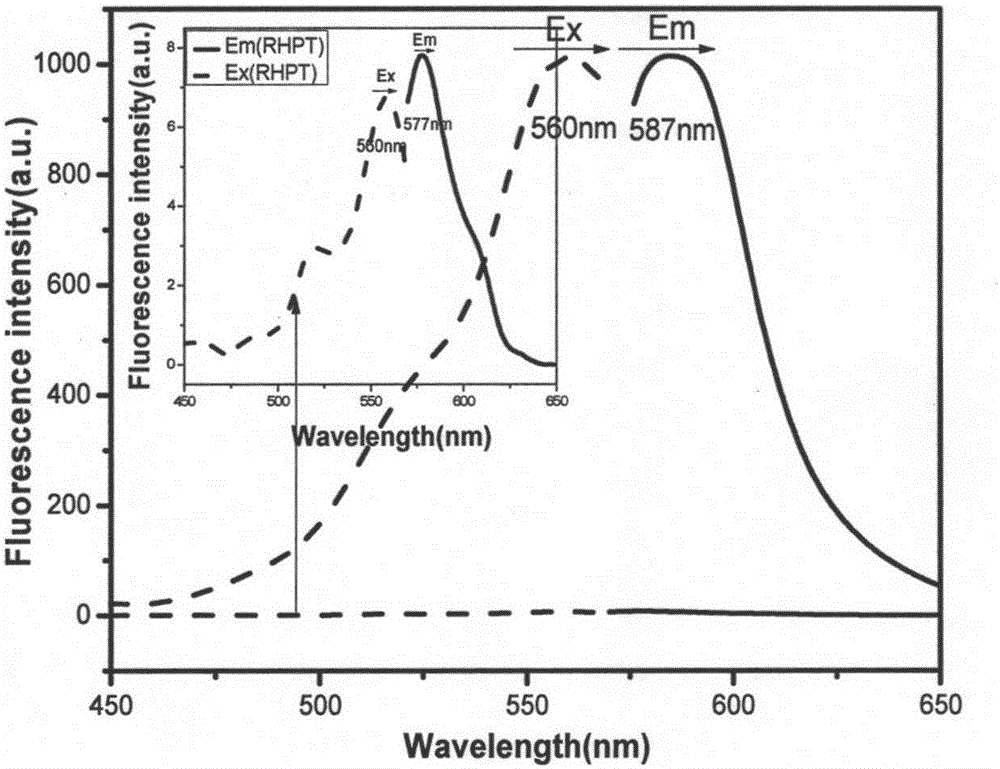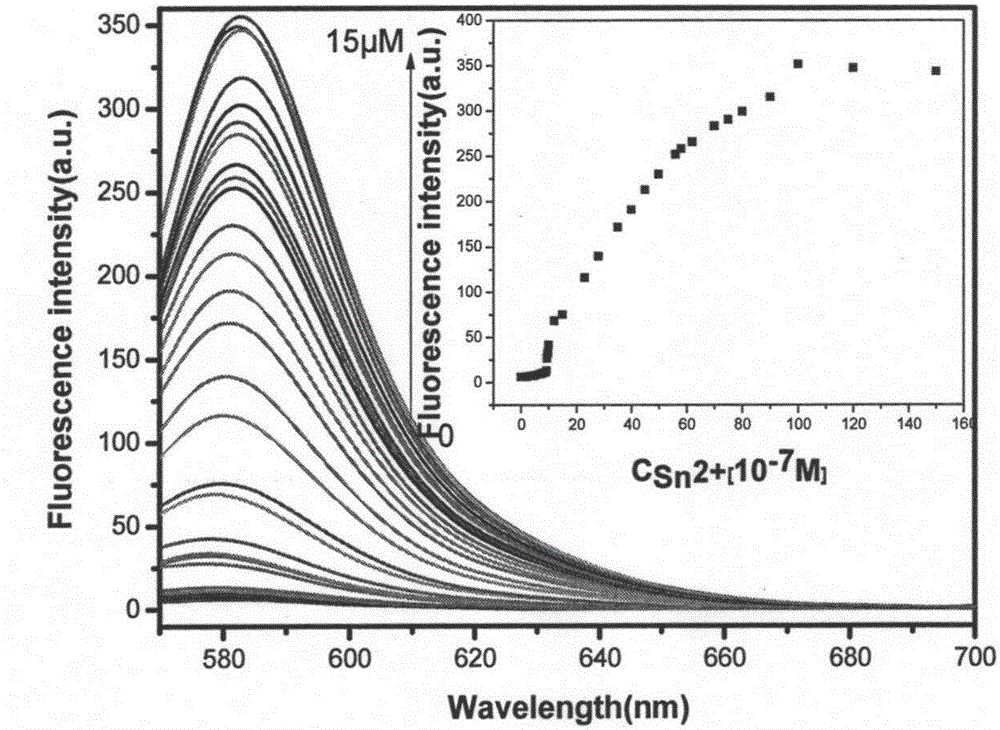Method for detecting stannous ions by using rhodamine fluorescence probe
A fluorescent probe, tin ion technology, applied in the field of fluorescent probe material detection, achieves the effects of high fluorescence intensity, good selectivity and simple operation
- Summary
- Abstract
- Description
- Claims
- Application Information
AI Technical Summary
Problems solved by technology
Method used
Image
Examples
Embodiment 1
[0042] (1) Dissolve rhodamine-based fluorescent probes in acetonitrile solvent to prepare a 10 μM fluorescent probe solution, dissolve rhodamine-based fluorescent probes in acetonitrile solvent to prepare a 10 μM stannous ion solution, and dissolve 1.0 mL of 10 μM Fluorescent probe solution was added in 1.0mL 10μM stannous ion solution, and the UV change spectrum of fluorescent probe solution was tested before and after adding stannous ion solution, and the results were as follows: figure 1 shown.
[0043] (2) Dissolve the rhodamine-based fluorescent probe in an acetonitrile solvent to prepare a 10 μM fluorescent probe solution, dissolve the rhodamine-based fluorescent probe in an acetonitrile solvent to prepare a 10 μM stannous ion solution, and dissolve 1.0 mL of 10 μM Fluorescent probe solution was added to 1.0mL 10 μ M stannous ion solution, and the fluorescence change spectrum of fluorescent probe solution was tested before and after adding stannous ion solution, and the ...
Embodiment 2
[0050] A kind of method utilizing rhodamine fluorescent probe to detect stannous ion, concrete steps are:
[0051] Step 1: Prepare rhodamine-based fluorescent probe solution: the rhodamine-based fluorescent probe refers to the synthesis method of 201510869087.0 "Reactive rhodamine-based fluorescent probe for detecting mercury ions and its preparation and application". The preparation method of the rhodamine-based fluorescent probe solution is as follows: a certain molar amount of rhodamine-based fluorescent probe is configured in an acetonitrile solvent so that the concentration of 100mL is 1×10 -3 M fluorescent probe solution, then take 1mL of the above concentration to be 1x10 -3 The fluorescent probe solution of M was added to a 10mL dry volumetric flask, then fixed to volume with acetonitrile solvent and shaken to obtain 1x10 -4 M fluorescent probe solution, take 1mL of the above concentration is 1x10 -4 The fluorescent probe solution of M was added to a 10mL dry volumet...
Embodiment 3
[0057] Step 1: Prepare rhodamine-based fluorescent probe solution: the rhodamine-based fluorescent probe refers to the synthesis method of 201510869087.0 "Reactive rhodamine-based fluorescent probe for detecting mercury ions and its preparation and application". The preparation method of the rhodamine-based fluorescent probe solution is as follows: a certain molar amount of rhodamine-based fluorescent probe is configured in an acetonitrile solvent so that the concentration of 100mL is 1×10 -3 M fluorescent probe solution, then take 1mL of the above concentration to be 1x10 -3The fluorescent probe solution of M was added to a 10mL dry volumetric flask, then fixed to volume with acetonitrile solvent and shaken to obtain 1x10 -4 M fluorescent probe solution, take 1mL of the above concentration is 1x10 -4 The fluorescent probe solution of M was added to a 10mL dry volumetric flask, then fixed to volume with acetonitrile solvent and shaken to obtain 1x10 -5 The rhodamine fluoresc...
PUM
 Login to View More
Login to View More Abstract
Description
Claims
Application Information
 Login to View More
Login to View More - R&D
- Intellectual Property
- Life Sciences
- Materials
- Tech Scout
- Unparalleled Data Quality
- Higher Quality Content
- 60% Fewer Hallucinations
Browse by: Latest US Patents, China's latest patents, Technical Efficacy Thesaurus, Application Domain, Technology Topic, Popular Technical Reports.
© 2025 PatSnap. All rights reserved.Legal|Privacy policy|Modern Slavery Act Transparency Statement|Sitemap|About US| Contact US: help@patsnap.com



